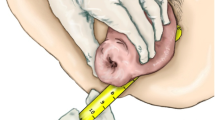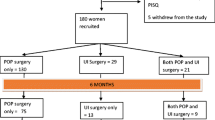Abstract
Introduction and hypothesis
Most of the literature on pelvic organ prolapse (POP) has been generated from postmenopausal patients in high-income countries. In the Democratic Republic of the Congo (DRC), a significant proportion of patients who present for surgical management of POP are premenopausal. Little is known about the impact of POP on pelvic floor symptoms in this population. The objective was to describe pelvic floor symptoms and sexual function among premenopausal patients presenting for POP surgery in DRC.
Methods
We performed a prospective cohort study of symptomatic premenopausal patients undergoing fertility-sparing POP surgery at a large referral hospital in the DRC. Pelvic floor symptoms were evaluated with the Pelvic Floor Distress Inventory Questionnaire and sexual function with the Pelvic organ prolapse/urinary Incontinence Sexual Questionnaire. Data are presented as means with standard deviations or counts with percentages.
Results
A total of 107 patients were recruited between April 2019 and December 2021. All had either stage III (95.3%) or stage IV (4.7%) prolapse. Ages were 34.2 ± 6.7 years; 78.5% were married. A majority of patients experienced low abdominal pain (82.2%), heaviness or dullness (95.3%), and bulging or protrusion of the prolapse (92.5%). Almost two-thirds of patients reported no longer being sexually active, and 80% stated that they were not sexually active because of POP. Of the 37 sexually active patients (34.6%), nearly all reported significant sexual impairment because of the prolapse, with only 4 reporting no sexual impairment.
Conclusions
This study represents one of the largest prospective series of patients with premenopausal POP. Our results highlight the severity of pelvic floor symptoms and the negative effects on sexual function among this patient population with POP.
Similar content being viewed by others
Data Availability
The data that support the findings of this study are available from the corresponding author, AW, upon reasonable request.
References
Hendrix SL, Clark A, Nygaard I, Aragaki A, Barnabei V, McTiernan A. Pelvic organ prolapse in the Women’s Health Initiative: gravity and gravidity. Am J Obstet Gynecol. 2002;186:1160–1166. https://doi.org/10.1067/mob.2002.123819.
Nygaard I, Bradley C, Brandt D. Pelvic organ prolapse in older women: prevalence and risk factors. Obstet Gynecol. 2004;104:489–97. https://doi.org/10.1097/01.AOG.0000136100.10818.d8.
Walker GJA, Gunasekera P. Pelvic organ prolapse and incontinence in developing countries: review of prevalence and risk factors. Int Urogynecol J. 2011;22:127–35. https://doi.org/10.1007/s00192-010-1215-0.
Scherf C, Morison L, Fiander A, Ekpo G, Walraven G. Epidemiology of pelvic organ prolapse in rural Gambia, West Africa. BJOG. 2002;109:431–6. https://doi.org/10.1111/j.1471-0528.2002.01109.x.
Brækken IH, Majida M, Ellström Engh M, Holme IM, Bø K. Pelvic floor function is independently associated with pelvic organ prolapse. BJOG. 2009;116:1706–14. https://doi.org/10.1111/j.1471-0528.2009.02379.x.
Woodman PJ, Swift SE, O’Boyle AL, et al. Prevalence of severe pelvic organ prolapse in relation to job description and socioeconomic status: a multicenter cross-sectional study. Int Urogynecol J. 2006;17:340–5. https://doi.org/10.1007/s00192-005-0009-2.
Nygaard IE, Shaw JM. Physical activity and the pelvic floor. Am J Obstet Gynecol. 2016;214:164–71. https://doi.org/10.1016/j.ajog.2015.08.067.
Belayneh T, Gebeyehu A, Adefris M, Rortveit G, Awoke T. Pelvic organ prolapse in Northwest Ethiopia: a population-based study. Int Urogynecol J. 2020;31:1873–81. https://doi.org/10.1007/s00192-019-04196-1.
World Fertility Patterns 2015 – Data Booklet (ST/ESA/ SER. A/370). United Nations, Department of Economic and Social Affairs, Population Division. 2015.
Islam RM, Oldroyd J, Rana J, Romero L, Karim MN. Prevalence of symptomatic pelvic floor disorders in community-dwelling women in low and middle-income countries: a systematic review and meta-analysis. Int Urogynecol J. 2019;30:2001–11. https://doi.org/10.1007/s00192-019-03992-z.
Ntakwinja M, Borazjani A, Vodusek Z, Tambwe AM, Mukwege D. Surgical management of pelvic organ prolapse in a high-volume resource-limited setting. Int J Gynecol Obstet. 2022;156:145–50. https://doi.org/10.1002/ijgo.13684.
Fatton B, Letouzey V, Lagrange E, Mares P, Jacquetin B, de Tayrac R. Validation linguistique en français de la version courte du questionnaire sur la sexualité (PISQ-12) chez les patientes présentant un prolapsus génital et/ou une incontinence urinaire. J Gynecol Obstet Biol Reprod. 2009;38:662–7. https://doi.org/10.1016/j.jgyn.2009.02.008.
De Tayrac R, Deval B, Fernandez H, Marès P. Development of a linguistically validated French version of two short-form, condition-specific quality of life questionnaires for women with pelvic floor disorders (PFDI-20 and PFIQ-7). J Gynecol Obstet Biol Reprod. 2007;36:738–48. https://doi.org/10.1016/j.jgyn.2007.08.002.
Rogers RG, Coates KW, Kammerer-Doak D, Khalsa S, Qualls C. A short form of the Pelvic Organ Prolapse/Urinary Incontinence Sexual Questionnaire (PISQ-12). Int Urogynecol J. 2003;14:164–8. https://doi.org/10.1007/s00192-003-1063-2.
Rogers RG, Kammerer-Doak D, Villarreal A, Coates K, Qualls C. A new instrument to measure sexual function in women with urinary incontinence or pelvic organ prolapse. Am J Obstet Gynecol. 2001;184:552–8. https://doi.org/10.1067/mob.2001.111100.
Johnson K, Scott J, Rughita B, et al. Association of sexual violence and human rights violations with physical and mental health in territories of the Eastern Democratic Republic of the Congo. JAMA. 2010;304:553–62. https://doi.org/10.1001/jama.2010.1086.
Larsudd-Kåverud J, Gyhagen J, Åkervall S, Molin M, Milsom I, Wagg A, Gyhagen M. The influence of pregnancy, parity, and mode of delivery on urinary incontinence and prolapse surgery—a national register study. Am J Obstet Gynecol. 2023;228:61.e1–e13. https://doi.org/10.1016/j.ajog.2022.07.035.
Gjerde JL, Rortveit G, Adefris M, Mekonnen H, Belayneh T, Blystad A. The lucky ones get cured: health care seeking among women with pelvic organ prolapse in Amhara Region, Ethiopia. PLoS One 2018;13:e0207651. https://doi.org/10.1371/journal.pone.0207651.
Gjerde JL, Rortveit G, Muleta M, Adefris M, Blystad A. Living with pelvic organ prolapse: voices of women from Amhara region, Ethiopia. Int Urogynecol J. 2017;28:361–6. https://doi.org/10.1007/s00192-016-3077-6.
Wusu-Ansah OK, Opare-Addo HS. Pelvic organ prolapse in rural Ghana. Int J Gynecol Obstet. 2008;103:121–4. https://doi.org/10.1016/j.ijgo.2008.06.014.
Ellerkmann RM, Cundiff GW, Melick CF, Nihira MA, Leffler K, Bent AE. Correlation of symptoms with location and severity of pelvic organ prolapse. Am J Obstet Gynecol. 2001;185:1332–8. https://doi.org/10.1067/mob.2001.119078.
Barber MD, Visco AG, Wyman JF, Fantl JA, Bump RC. Sexual function in women with urinary incontinence and pelvic organ prolapse. Obstet Gynecol. 2002;99:281–9. https://doi.org/10.1016/S0029-7844(01)01727-6.
Handa VL, Cundiff G, Chang HH, Helzlsouer KJ. Female sexual function and pelvic floor disorders. Obstet Gynecol. 2008;111:1045–52. https://doi.org/10.1097/AOG.0b013e31816bbe85.
Weber AM, Walters MD, Schover LR, Mitchinson A. Sexual function in women with uterovaginal prolapse and urinary incontinence. Obstet Gynecol. 1995;85:483–7. https://doi.org/10.1016/0029-7844(94)00434-F.
Rogers GR, Villarreal A, Kammerer-Doak D, Qualls C. Sexual function in women with and without urinary incontinence and/or pelvic organ prolapse. Int Urogynecol J. 2001;12:361–5. https://doi.org/10.1007/s001920170012.
Özel B, White T, Urwitz-Lane R, Minaglia S. The impact of pelvic organ prolapse on sexual function in women with urinary incontinence. Int Urogynecol J. 2006;17:14–7. https://doi.org/10.1007/s00192-005-1327-0.
Shrestha B, Onta S, Choulagai B, et al. Women’s experiences and health care-seeking practices in relation to uterine prolapse in a hill district of Nepal. BMC Womens Health 2014;14:20. https://doi.org/10.1186/1472-6874-14-20.
Rahman A, Toubia N. Female genital mutilation: a guide to laws and policies worldwide. Zed Books, London; 2000.
Goba GK, Legesse AY, Zelelow YB, et al. Reliability and validity of the Tigrigna version of the Pelvic Floor Distress Inventory-Short Form 20 (PFDI-20) and Pelvic Floor Impact Questionnaire-7 (PFIQ-7). Int Urogynecol J. 2019;30:65–70. https://doi.org/10.1007/s00192-018-3583-9.
Author information
Authors and Affiliations
Contributions
M. Ntakwinja: project development, data collection, manuscript writing; A. Werth: data analysis, manuscript writing; A. Borazjani: data analysis, manuscript writing; C. Iglesia: manuscript writing; K.J. Williams: manuscript writing; D. Mukwege: project development, manuscript editing.
Corresponding author
Ethics declarations
Conflicts of interest
M. Ntakwinja: none; A. Werth: none; A. Borazjani: patents related to treatments and diagnostics for pelvic floor disorders, consultant and equity shareholder in Cosm Medical Corp; C. Iglesia: SGS executive board, NICHD PFDN pelvic floor disorders network advisory board chair, US FDA OBGYN Devices Panel special government employee, medical advisory board member for the Patty Brisben Foundation, Editorial board for Urogynecology journal and OBGManagement journal; K. Williams: none; D. Mukwege: none.
Additional information
Publisher's note
Springer Nature remains neutral with regard to jurisdictional claims in published maps and institutional affiliations.
Rights and permissions
Springer Nature or its licensor (e.g. a society or other partner) holds exclusive rights to this article under a publishing agreement with the author(s) or other rightsholder(s); author self-archiving of the accepted manuscript version of this article is solely governed by the terms of such publishing agreement and applicable law.
About this article
Cite this article
Ntakwinja, M., Werth, A., Borazjani, A. et al. Pelvic floor symptoms among premenopausal women with pelvic organ prolapse in the Democratic Republic of the Congo. Int Urogynecol J 35, 103–108 (2024). https://doi.org/10.1007/s00192-023-05670-7
Received:
Accepted:
Published:
Issue Date:
DOI: https://doi.org/10.1007/s00192-023-05670-7




